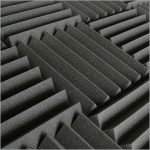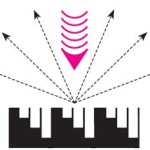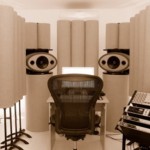Just like buying a car, building and improving a home recording studio comes down to research, test drives, and personal preference. Your space is the driving force of your business and creativity; the control room of your brand. No single solution is going to work for any two studios or individuals so… Below is a list of 26 hot topics you should consider, research, and test drive in your constant pursuit of improving your studio.
A is for Absorption. Any room that hasn’t been built from the ground up with recording in mind needs it. This is the crucial first step to harnessing the soundwaves in your room, for both high-quality tracks and mixes.
Recommendation: Auralex is an easy (yet expensive) solution, as is hiring an acoustician to come survey your room. However, I think I can save you a lot of time (and money) if you watch my DIY absorption panel video.
B is for Blog. I know, I’m only on the second letter and already throwing time-consuming tasks your way but hear me out. From experience, I know that your audience doesn’t just want to hear the amazing music you’re creating. We need more than that. We want to hear the how, when, where, and why behind everything you do.
Recommendation: There are many pre-made blog sites out there such as Tumblr or Blogger but my personal recommendation is to set yourself up for success and build a custom website powered by WordPress. (just like SOSstudio.co)
C is for Clock. Picture this: You’re sitting at your desk, futzing with a mix that seems to be right on the edge of really opening up. “Just 10 more minutes,” you say. 3 hours later you look up and realize you forgot to eat, your eyes are shaking from screen fatigue, and you have a headache from being slumped over for hours. It happens ALL the time!
Recommendation: Set a timer for 1-2 hours and then go take a walk, listen to some different music (or no music), eat an apple, whatever you feel like doing to provide a much-needed reset for your eyes, ears, and brain. You will be more creative and efficient by stepping away from your project for a couple of minutes at a time.
D is for Diffusion. The effect diffusion has in a studio is incredible. Rather than absorbing the sound waves and knocking them out, diffusion scatters the sound into countless directions so that there are no direct reflections. This allows your small room chock-full of 90-degree angles to sound like a much larger space with bright, open acoustics.
Recommendation: Fill 1/3 of your room with absorption panels, 1/3 with diffusion panels, and 1/3 with bookshelves or other dynamic pieces that break up the flat wall spaces, essentially serving as additional diffusion. Check out my DIY diffusion panel video to see how you can take this into your own hands. Tip: If you’re really feeling ambitious, fill the final 1/3 of your room with tube traps (‘T’ below).
E is for Ear Protection. I’m not going to go all OSHA on you but dude/dudette, your ears are your life when you’re working in a studio. The more you can invest in protection, the longer you can enjoy your career. In a home studio, you may not have the luxury of a live room and a control room so make sure you’re equally protected from high db’s and isolated enough to hear the true quality of what your mics are capturing.
Recommendation: Invest in some custom in-ear monitors. JH Audio, Alien Ears, Ultimate Ears, will all rock your socks. (without killing your wallet)
F is for Free Plugins. Free is always good and so many major companies out there want to offer you free swag for you to become customers for life. Not all are gems. But you can easily find a $100 plugin for free (or a $250 plugin for $29). Even if what you find is not your favorite, save it because there will always be that 1 time it’ll be exactly what you need.
Recommendation: Make it a daily routine to visit your favorite software companies’ websites. Often they’ll list deals or promotions right on their page. To get a concise view of cool deals across the board, sign up for the Stupid Deal of the Day on MusiciansFriend.com.
G is for Google Drive. I’m not even kidding when I say this is easily one of the most important letters on this list. Sharing files, scheduling meetings, building invoices, archiving old projects… all in one convenient place accessible by only you and shareable with anyone who has a Gmail address. It allows you to put your home studio in the cloud and share projects with other home studios. The best part? Additional storage is a fraction of the price of services like Dropbox.
Recommendation: Start utilizing the free 15gb of storage that come with a Gmail address. After you have enough files, upgrade to the 100gb plan for $20/yr. That’s right! Not $20 per month… $20 per YEAR. (I’m not affiliated with Google. I just love Drive so much, I sound like a salesperson.)
H is for Human Collaboration. This is for those of us who think “I have my samples and software instruments that come with my DAW, I’ve got everything I’ll ever need.” To which I will reply, “If your goal is create demos of your songs, then you are set for life, my friend. Otherwise, you need people.” I don’t mean for that to sound harsh but samples offer no imperfections, no warmth, no humanity. Not to mention that, if all the work is coming from only one mind, it can never blossom to its full potential. Let collaborators take it to the next level!
Recommendation: This is the exact fabric out of which SOSstudio is cut. Never again do you need fake drums …or any other instrument for that matter… we’ve got drummers on standby. Looking for a high quality mix? We’ve got engineers chomping at the bit for working with new artists just to get a fresh set of ears. If this sounds up your alley, drop us a line. We love to talk music.
I is for Internet. Simply put, you’re going to be sharing a LOT of data. Save yourself the hassle of wasting countless hours of slow file transfers and just upgrade your internet speed to a faster plan. It may be a shock to the wallet at first but the amount of time it will save you to schedule billable hours, you’ll earn your money back in no time.
Recommendation: Visit your ISP’s website and see what they have to offer. Sometimes calls rather than emails can bring around special rates.
J is for Joy. If you’re working out of a home studio, you are one of the luckiest people in the world. This is incredible! Creating all day, in your pajamas, only leaving the house for a nice dose of Vitamin D. In the stressful times, the hard part is to take a step back and realize just how good you have it. Even if your hard drive blows up (probably the worst thing that can happen to you), you can still recreate the tracks and besides… you have it all backed up to Google Drive, right?
Recommendation: Find a mantra. My personal mantra for when the little things start adding up… “Am I going to remember this moment in my final moments?” If not, then let it go and move on.
K is for Keyboard. Ok, here is my hypocritical moment: Yes, rely on human collaboration for your tracks. But, even if you don’t play keys, you need to have a keyboard or MIDI controller around for adding synths, textures, nuances, all the subtle (or featured) moments that make your track exceptional. Certain DAW’s allow for MIDI programming through your Qwerty keyboard but you will miss the dynamics from recording that way. Using a MIDI controller allows for touch-sensitive keys so your performance can match your vision.
Recommendation: This is the MIDI controller I have and I love it. It worked right out of the box, has a 4 octave range, and no other distracting bells and whistles. Of course, nothing beats going into a music store and test driving the options they have there (just don’t get tricked into upgrading beyond what you truly need in your studio).
L is for Layout. Consider your studio to be your zen garden. It can be designed any way you want but keep these 2 necessities in mind: Inspiration and Efficiency. Your flow is your main strategy. You must have a vibe in your space that allows you to feel inspired and hear new ideas, even when you hear crickets at first. You must be able to sit down and start recording immediately and efficiently once you hear these ideas.
Recommendation: This is your moment to make your studio your control room for your life and your brand. Include plenty of memorabilia, photos, books, trinkets, etc. so that you feel at ease in your space. But when you get to your desk, make it all business. A clean, organized workspace so that you can work immediately. You don’t want to clean papers away to find your keyboard. Buy some desktop folders, a file cabinet, whatever you need to keep your studio sacred, not cluttered.
M is for Monitors, Microphones, & Mixers, my my my. There is a wide variety of countless studies, opinions, and experts on the best gear out there but the short answer is this: You need what you need. Sounds ridiculous, I know. With monitors, microphones, headphones, cables, all of this comes down to personal preference, goals, and budget. For example, I know a woman who prefers to either sing into a Neumann U87 ($3500+) microphone or a Shure SM57 ($50). Both “fit” her voice, she’s perfectly happy with either, so it just depends on what the studio has available. But the saving grace is that she knows what works with her voice. You, as an engineer and recording artist, must be familiar enough with different gear that you can handpick what you want for your sound and then ask yourself: “How often will I be hosting other singers/musicians and what should I have on hand for them?” (Word to the wise- Options are usually better but if you only have a small arsenal of really awesome gear, your guests will hardly ever put up a fuss.)
Recommendation: Do as much research as you want but no opinions, including my own, are going to be the same as visiting a large music store and playing around with options. I’d start with sweetwater.com, since their sales reps are extremely knowledgable and they can help point you in the right direction. From there, you can either order something and send it back if it doesn’t feel right or you can use your knowledge to inform your decisions when you visit a store and hear all of the monitors, mics, and mixers side by side. You can succeed with anything you buy… you just need time and a good ear.
N is for Network and Newsletter. Newsletters are just as important (if not more) than social media and a website for your studio. As people hear your work, they will want to follow you and hear how else you are creating. By getting them to subscribe to your newsletter, you can send updates, articles, promotions, free music, and whatever else you can think of to them (in moderation of course). What’s even better is that, with a newsletter, if you build your network up but then change websites or careers, you can still bring your followers along with you to your new venture. You don’t have to start over; you can keep building relationships from where you left off.
Recommendation: For years I’ve used Mailchimp for both personal and business. The site offers a free plan that will be plenty for just about anyone. Recently, I switched over to AWeber, primarily because I really like their interface, I can set up an automated personalized email series that goes out when a new member has joined the list, and I keep hearing great things about the service from very influential people. Check them both out and see how you feel.
O P are for Online Promotion (or why not to put your music on Spotify). Between brilliant social media sites, powerful personal websites, and the ability to self-publish our albums, musicians have never been in a better position to share our music with the world. Yes, there are services that are terrible for musicians such as Spotify, but services like Soundcloud give you the power to let people hear and share your music for free. Consider offering free downloads in exchange for joining your newsletter so your followers can get exclusive content from straight from you. Getting a name on your list is incredibly more valuable than Spotify paying you $0.0084 per stream.
Recommendation: Start paying particular attention to those whom you follow and think are successful at how they promote themselves. Analyze their motivation behind each post. If possible, pick their brain about if this is all strategy or merely blind luck. Either way, you’ll have learned new ideas to implement into your own promotion.
Q is for Quality. This is a bit obvious to say but the quality of your studio and your music relies solely on your levels of commitment and personal development. For New Year’s, I wrote a post called 3 Steps to Keep Resolutions (and re-energize your music career) and, in it, I’ve laid out some pretty basic but powerful ways to break your larger goals down into smaller, actionable goals so that you never get overwhelmed by the overall project. If we as artists can break our projects down into smaller projects and focus on those one at a time, we will be able to dedicate ourselves fully to making the quality the best it can be.
Recommendation: Read this article and then start taking action on your next (or current) big project. Write down the steps necessary to get from where you are to the end, and keep them simple, direct, and actionable. For example, instead if jotting “record,” write “Set aside 2 hours on Monday to record tracks A, B, and C.”
R is for Rates. Say you’re walking down the street and a stranger runs up to you and says “Oh man, you’re [insert your name]! I love your work! Hey, I’ll pay anything… What do you charge?” It’s so important for you to value your time with a specific dollar amount. Not just for the moments like this when someone asks to hire you for your sweet skills. But, on a day-to-day basis, you need to know how much your time is worth to you so that you can make the best decisions for your business.
Recommendation: Answer these questions for yourself: What would I pay myself, knowing my efficiency, background, and skillset? Is there a time commitment that I should not take on over a certain amount of hours, regardless of money? How do I feel about taking on lower (or no) pay jobs if I’m helping someone as a charity?
S is for Software. The DAW (Digital Audio Workstation) you choose for your studio directly affects how efficiently you can create a finished product. Avid’s Pro Tools and Apple’s Logic Pro are mighty competitors at the top of their game and Ableton Live, Steinberg Cubase, and PreSonus Studio 1 are worth checking out as well. With any of these software options, you can create exceptional songs but the single most important action with any of these softwares is to commit to just one and learn it. Each is extremely powerful and worthwhile but even the most skilled engineer on Pro Tools will be completely lost in Logic and vise versa (unless you’re equally trained in both). This unfamiliarity with the software will eat up your time, kill creativity, and hinder you in your goals.
Recommendation: There truly is no “right” answer for this one. The most in-depth you need to go is to look at screen shots of the software (to see if one feels more comfortable) and make sure the system requirements are compatible with your computer. Budget plays a huge factor as well. Follow your gut and commit to one. There are hundreds of tutorials on each of these DAW’s all over YouTube and music forums; you can find any answer in a matter of seconds. Most importantly: be excited about it! This is the screen you’ll be staring at day in and day out so make sure it’s one that inspires you. If you want to discuss more options along the way, please reach out.
T is for Tube Traps. What’s a tube trap? Picture a big, cloth-covered column in the corner of your room. If you were to dissect it, the first layer would be high-density insulation (absorption) then a rigid tube with holes to scatter sound 360 degrees (diffusion), then even more insulation on the inside. This breaks the sturdier, more stubborn bass frequencies in any room down into smaller and weaker frequencies that get scattered or absorbed. Also, by placing them in the corners of your room, you are actively solving the trouble spots of any room: eradicating right angles.
Recommendation: Buying tube traps are major expensive and building them DIY are definitely one of the more time-consuming ventures you’ll undertake with your studio. I’ve worked with an acoustician on schematics and have made some DIY adjustments of my own to build tube traps from scratch for a fraction of the cost you can buy them. I’m currently working on the video teaching you exactly how to do this yourself. If you want to be notified as soon as it comes out, sign up for our newsletter here and you’ll get it ASAP!
U is for Upgrade. The topic of whether or not to upgrade your DAW or other gear to the latest version is one that plagues many online forums. Often, when ‘new’ versions of these softwares come out, they are glitchy and only somewhat reliable until patches are developed and distributed. And every time you will be introduced to new features or modified layouts that will disrupt your flow in some way.
Recommendation: Work with your current version as long as possible, since that is the version you know inside and out. Only choose to update if there is a feature that is so cool you can’t live without it or if the new version fixes some problems you have with your current version. And EVEN THEN, wait 1-2 months after the release to allow some bugs to get worked out.
V is for Vocal Booth. Again, most home studios have 1 big room that serves as both live room and control room. Those of us with isolated, soundproofed vocal booths are extremely fortunate. Here’s an idea: more than likely, your studio is a converted room in your house (probably a bedroom) with an attached closet. If you can spare the space and resources, consider turning your closet in an isolated vocal booth. If there are clothes inside, keep them. They’ll serve as a nice absorption and then you can just add some absorption panels to the walls and door that will have direct reflections. You can consider putting a double-paned glass door in so that the vocalist and engineer can see each other during conversations.
Recommendation: If you are a vocal artist, a closet or attached room with bring the best results. However, there are many alternatives to making adjustments in your studio such as hanging moving blankets in a 360 degree column and standing inside or following this simple DIY video on YouTube. (I haven’t used this video but it looks like a cheap, easy-to-implement idea)
W is for Website. Even if you have no interest in a blog or promoting yourself, I’d still recommend you have a website so that, if someone searches for you after an in-person conversation, they can at least find a simple page with a phone number, photo, and contact form. Otherwise, if they lost your card, you are forgotten.
Recommendation: The most powerful, and my preferred method, is WordPress. You can host wordpress on your own domain through GoDaddy.com. (Not sure what that mean? Just call GoDaddy.) I use a fantastic site of templates called Elegant Themes to bring my pages to life. I love them, they are extremely professional, and they have great customer service.
X Y Z is for what is yet to come. As an owner and sole employee of your home studio, you are an entrepreneur, forging your brand through trial and error until you find success. There will be hiccups, there will be bursts of inspiration… your job is to continually improve by learning, adjusting, and committing to being the best version of yourself you can be and by making TODAY the best day it can be.
Revisit this list often for inspiration and new ideas, as I will update it with your feedback and insights. If you would like to join the conversation, please leave a comment below and we’ll all figure this out together!
Dear Reader: What aspects of your studio are you proud of? Where can you see room for improvement? Do you already have plans for improvement; what’s on the list?
